Welcome to the Brown History Newsletter. If you’re enjoying this labor of love, please do consider becoming a paid subscriber. Your contribution would help pay the writers and illustrators and support this weekly publication. If you like to submit a writing piece, please send me a pitch by email at brownhistory1947@gmail.com.
Don’t forget to check out our SHOP and our Podcast.
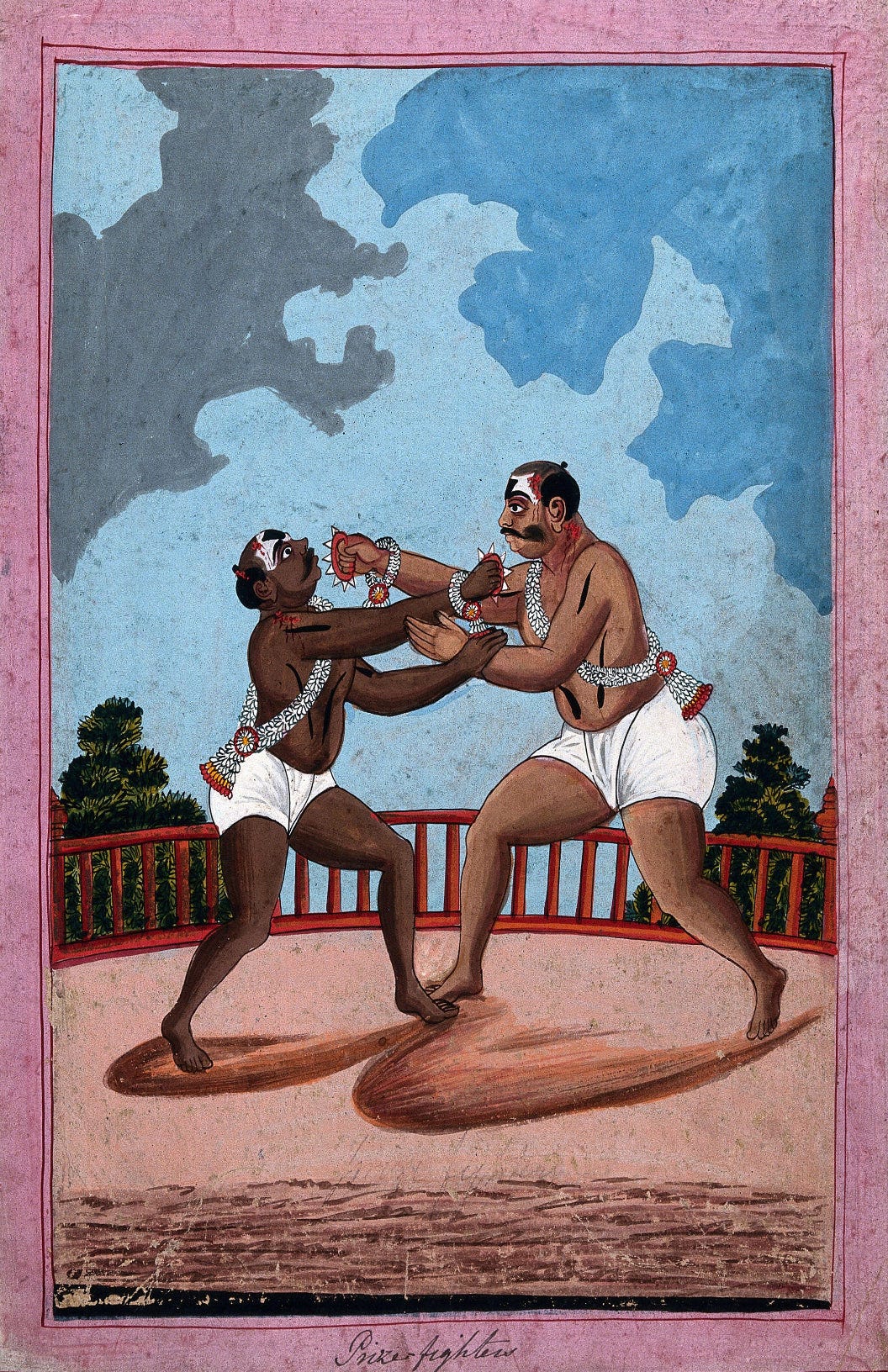
Recommended Reads:
The Sutlej River: Where the Waters Divide
A film crew journeys to banks of the Sutlej River, where India and Pakistan meet, to document the river’s changing fate. As the team films, forgotten histories resurface.
The lush green fields glistened after the continuous monsoon showers. The earth beneath our feet softens. Humidity rises. Air is still. We hop from Mahi Wala to Chanda Singh Wala, villages on the banks of river Sutlej and on the border between India and Pakistan in Punjab.
Sutlej was known as Shuturdi in the Vedas and Mahabharata. Legend has it that thousands of years ago, a sage called Vasishta, devastated by the death of his sons, wandered around. He saw a river, swollen after the monsoon rain had poured down in torrents. He jumped in the river to commit suicide. The river dilated itself and fled in a hundred different directions. Vasishta landed on dry land and was unharmed. The river was named Shutudri, which means the river of a hundred different directions. Today, this river cuts through the hard borders of China, India and Pakistan and is aching for its own freedom and life.
In Pakistan, probing deep into the past could be precarious. It may create a sense of belonging but it also reveals the divide within. You may find parts of yourself that you are familiar with but also the ones that you apparently decided to chop off. Much like today’s Sutlej. We have come to the river to find its story, the fault lines buried deep within.

We have gone to several houses, had tea and pakoras in a dilapidated tea shop and met the fishermen on the banks of the river. The stories we hear of river Sutlej are captivating; myths and legends, tragedies and triumphs spreading over decades and centuries. Time seems like a string with no ends or beginnings and Sutlej's stories come together like titillating beads of a string. Each bead adds another layer, creates another marvel, reveals another secret.
The old man tells us the folklore and songs; stories of Sutlej’s oneness with its people, its mighty power to create and sustain life and death. He tells us stories of Sutlej’s waters being colonized. Greed and extraction changed its colours. Borders cut its belly and the 1947 Partition turned it red. The political treaties divided the Indus. The sacred bond was broken. The young boy tells us the river has hardened. He tells us stories of its waters turning into poison, its fish and frogs dying, its land, jungles and ecosystem destroyed and its anger unleashes without a warning. The mother tells us the waters saved the baby.
Nirmal Bano, comrade and confidant, and I had found a collective purpose to share Sutlej’s story. We secured a small grant for making a documentary and started spending our days on its banks. The Sutlej river has been a silent witness to the tumultuous history of the region. Its waters have seen the rise and fall of empires, the birth of new nations, and the displacement of countless people. As I listen to the stories of the locals, I am struck by the river’s enduring presence in their lives. For them, Sutlej is more than a river - it is a symbol of their identity, their culture, and their resilience.
As I stand on the banks of the Sutlej, I am met with a mix of emotions. The river, which flows through the heart of Punjab holds a deep significance for me. Sutlej, the river of the Rig Vedas, of revolutionaries, of martyrs and their mothers; its waters flowing from Tibet in the Himalayas to Himachal Pradesh to and across Punjab is of astounding relevance. We have come to document its story, to unravel the myths and legends that surround it, and to explore the impact of the 1947 Partition on the communities that call it home. However, almost immediately, the impact of the colonial gaze blind to indigenous cultures and values becomes evident. Capitalist ways have led to a cold indifference and paved the way to reduce the river down to a monetary worth and eventually a site of dumping waste of the big cities it is surrounded by. Lahore, the hub of culture and history of Pakistan dumps multiple sewage pipes into the river. The tragedy can not be missed.
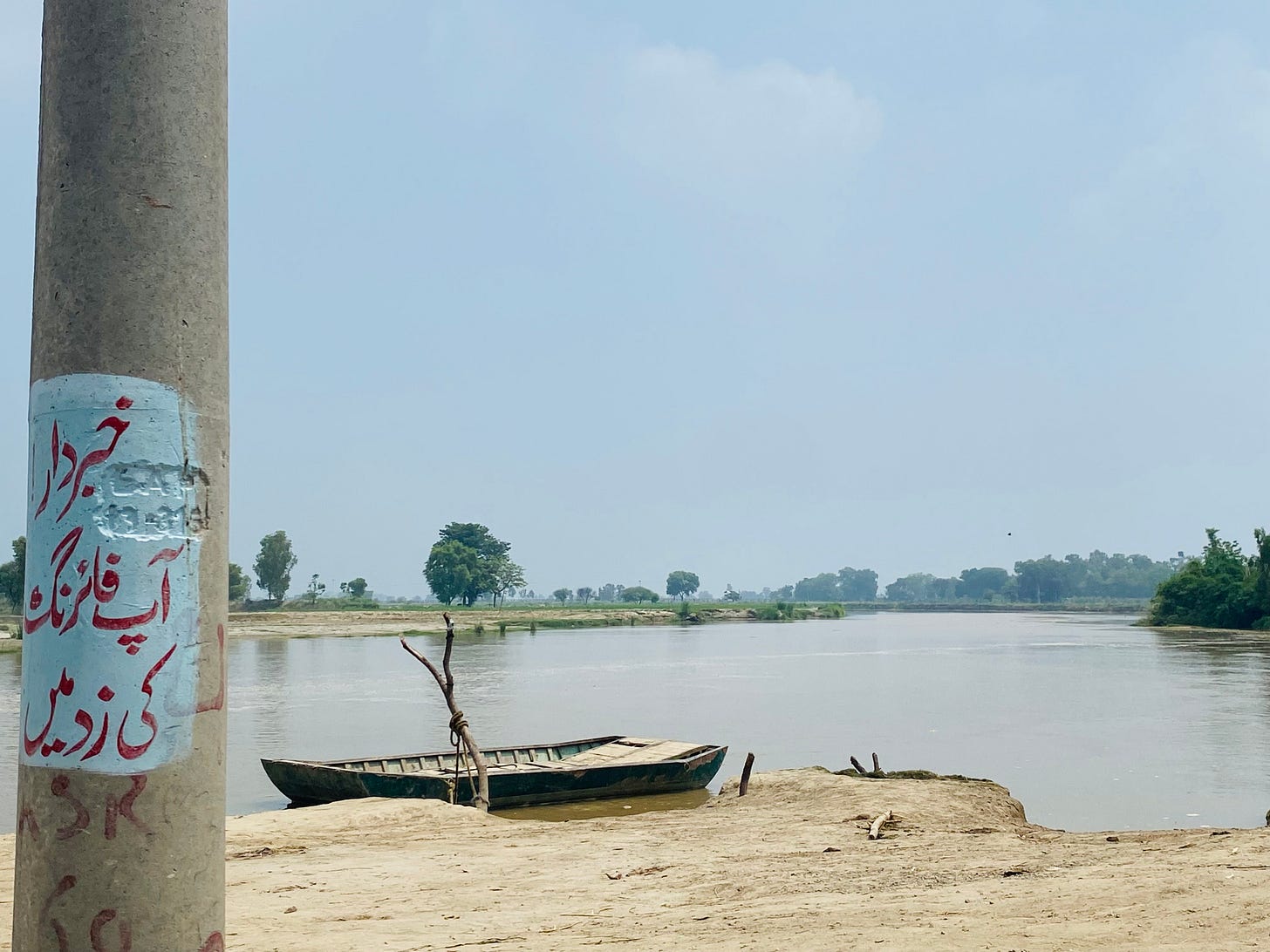
Sutlej stretches over 1450km making it one of the longest rivers in South Asia. Almost one third of the river falls in Pakistan. However, in Pakistan, it's almost forgotten; a process that was rooted in the 1947 Partition and then finally completed after the Indus Water treaty of 1960. The historical treaty divided the Indus with the aim of resolving the conflict of water between the two nations. India controls the Ravi, Sutlej, and Beas rivers in the east, while Pakistan controls the Jhelum, Chenab, and Indus rivers in the west. Thus began, the process of choking the rivers, building dams, occupying the river’s lands, destroying its ecosystem and a race to extract, abuse and control more. A violent disconnect has been made between the river and its world.
Of the many stories we hear, the one that jolts our insides is that of Bhagat Singh’s.
Bhagat Singh, Rajduru and Sukhdev were hanged on 23rd March 1931 in Lahore by the British Raj, a night before the court had ordered. The execution was a guarded secret until the jail authorities had sneaked the bodies out and away, performing a hurried cremation and depriving the families even the basic right of performing last rites of the young gone with dignity. Many painful stories of the execution are told such as the jail authorities dragging their bodies along the dirty passageway, stuffing them into sacks and whisking them out of the jail. They were taken to the banks of the Sutlej in the village of Hussainiwala where they were “loaded onto a (single) funeral pyre to burn fiercely in the eerie silence of the night”.
The killing of the three young revolutionaries not only unmasks the barbarity but also the loathing and deep fear of the empire from people who shed off above the fear indicted by the state. The barbarity with which the three revolutionaries were killed and then cremated ruptured/upended the facade of the empire.
Later, Bhagat Singh’s mother, Vidyavathi devi, passed away in the year 1975. She lived a long life in yearning for her son and had willed to be cremated on the banks of River Sutlej. It was the same place, Hussainiwala, where Bhagat Singh along with his comrades Rajguru and Sukhdev were cremated secretly by the British.
The mother met her sons.
Despite being the direct result of colonial oppression and the violence at its center, the narrative around the 1931 execution of Bhagat Singh has evolved into a popular motif present in South Asia’s many resistance struggles. His execution is not solely a reminder for colonial powers’ terrifying brutality but also of the inevitable triumph. Sutlej is the living witness of our struggle for freedom. The river is Bhagat Singh and his comrades final resting place. It's where his mother, Vidhyvati Kaur, chose to live after her death. It's forever a symbol of triumph of truth over evil, of justice over cruelty. The history of Bhagat Singh, Sutlej and the freedom of this land is eternally one. A palpable feeling that occasionally weighs us down during the making of the film is that we belong to the river and its death is our death.
____________________________________________________________________________
The first day of our documentary shoot arrives. I have gone through multiple never-enough goodbyes with my five-year-old son and three-year-old daughter, Kabir and Heer. At bedtime, we had talked about Sutlej river, the stories my team and I had discovered and the filming this week. We talk about saving the river, cleaning its waters, and feeding the fish.
In the early hours of the morning, the team gathers at my place in Lahore. We drink cold glasses of water in anticipation of a hot humid day and hot cups of tea in fear of not finding enough. We speak in exhilarating tones in the quiet hours of the morning. Nirmal and I relish the small yet impassioned team present in the room. Kabir and Heer’s big eyes are wide open and curious. They lend us their umbrellas as unexpected monsoon rain pours and none of us have packed any. I carry their belongings believing it is a good omen and realize the hope I gave them last night has rubbed off of me.
We leave Lahore for the villages on the banks of river Sutlej near Kasur in the early hours of the morning. The crew of three women and five men divide themselves in two cars. The electric energy of purposefulness flows through everyone in the car. The intercity highway that connects Lahore and Kasur goes by the name of Ferozepur Road as it once led to the city of Ferozepur which now belongs to India’s Punjab. The highway traffic is disagreeable as ever and the magnitude of the day’s work ahead brings forth the first wave of apprehension. Someone mentions the brutal temperature forecast for the day. Another one is calculating time to pack maximum shots and interviews on the first day.
We decide to distract ourselves from the various possible hiccups and listen to a ghori. Ghori is a folk Punjabi song, typically sung by women as the bridegroom mounts an adorned horse and sets off for the bride’s house. The song is a prelude to the joyous times ahead. This particular ghori however, chronicles the night Bhagat Singh marched to the gallows with an imposing pride and re-tells the event as a traditional baraat procession.
This particular ghori was sung by a poet named Tair on 23rd March 1932 when about one lakh people had gathered in Lahore to celebrate the first martyrdom anniversary of Bhagat Singh.
Aao ni behnon ral mil gayee-ay ghorian, junj te hui hai tayeer ni haan
Come on sisters, Let us sing together the songs of marriage, the ghorian
The wedding procession, janjh, has got ready
maut kurray nu layavan chale aan desh bhagat sardaar ni haan
Patriot Bhagat Singh is on his way
To wed the maiden of death
For months we had shared with each other our anxieties around the military surveillance of the Sutlej river and villages like Mahi Wala and Chanda Singh in Kasur that are situated on the India-Pakistan border. Almost 105 kilometers (65 miles) of the Sutlej River acts as the India-Pakistan border. We crossed several check-posts to reach the banks of the river on multiple recce trips. Every time we remained weary of the check-posts but we crossed them without causing any alarm. However, things might be different when we come with the full film crew. It was always at the back of my mind.
As we begin our journey, we are reminded of the complex history of the region. As we got close to the Sutlej and its waters, we received a call from our line-producer, a primary school teacher from one of the villages. He checked his duty by informing us of the possibility of our cars being searched arbitrarily as that seemed to be the order of the day. The army check-posts are not an out of the ordinary occurrence for Pakistanis. Their presence around LOC can be warranted but they are also a regular feature in most urban centers with a cantonment. However, their prevalence does not help in the face of what sits in our car boots. Two video cameras and sound recording equipment. No one has a military ‘connection’ who can sweep us out of the situation last minute. A convincing performance of smug confidence along with quick-wit is all we can rely on. We start taking measures to prove our innocence is in fact, innocent. We reshuffle so that both cars would have at least one woman sitting in the front. It is a fail-safe trick to appear non-threatening at a check-post. We cross one check post but another one looms ahead of us.
As expected, a man in a drab uniform signals to stop us. We slowed down the cars and parked on the side. We are accustomed to the process. We hand over our identity cards and give careful explanations of our presence in their world this morning, and otherwise. The officials are respectful. We avoid using words like border, India and floods and only offer information that can be easily digested. They are unaffected and ask us to open the boot of the cars. We ask our male crew to remain seated in the cars. Nirmal and I stepped out. We remain calm and cool, knowing our entire project and months of planning and preparations are at the behest of the man in the uniform. Just the right amount of words are being spoken. Not too many or too little. Our mere proximity to a ‘sensitive’ area is enough to turn us down. They inspect each and every piece of the equipment. We are now explaining the equipment and its purpose. They are insistent on opening every bag and box ensuring there is nothing objectionable. Unable to look at the slow-burn performance and weighed down by the what-ifs, we step away and our gaze runs through the entire scene. The boot of the cars opened. All the equipment is out from the zipped bags that the military officials are peeking into and we are standing in front of a small nondescript room and a manual arm barrier on the road. Just behind us is a war memorial.
After thirty odd eternal minutes, we are allowed to go. Our ordeal has ended – for now. This, however, is not the only brush, which we have with the border guards, colloquially known as the rangers.
After spending the first day of shooting indoors in our protagonist's homes, we make our way to the banks of river Sutlej on the second day. Despite the raging sun beating down on us, the gentle breeze serves as an antidote. As we near the banks, the soft sound of the lapping waves fill up the soundscape. The fervent agitation we had felt so far makes way for a balmy lull. The quiet of the surroundings inspires a drop in our voice levels. We wait patiently for the food arriving from the nearby town and eat at a lavish pace as it arrives. The reality of being present at a heavily militarized border isn’t completely avoidable. There is a shadow lurking around; an intuition that somebody is watching, listening to our conversations.
One of our main characters in the documentary is Khairuddin, a creature of the river and its surroundings. He carries a gentle peace within himself, a comfort of knowing the benevolence and the darkness of the river and its surroundings. He is a fisherman who has lived on the banks of the river for over forty years. His stories are a testament to the river’s power and majesty, and we are humbled by his wisdom.
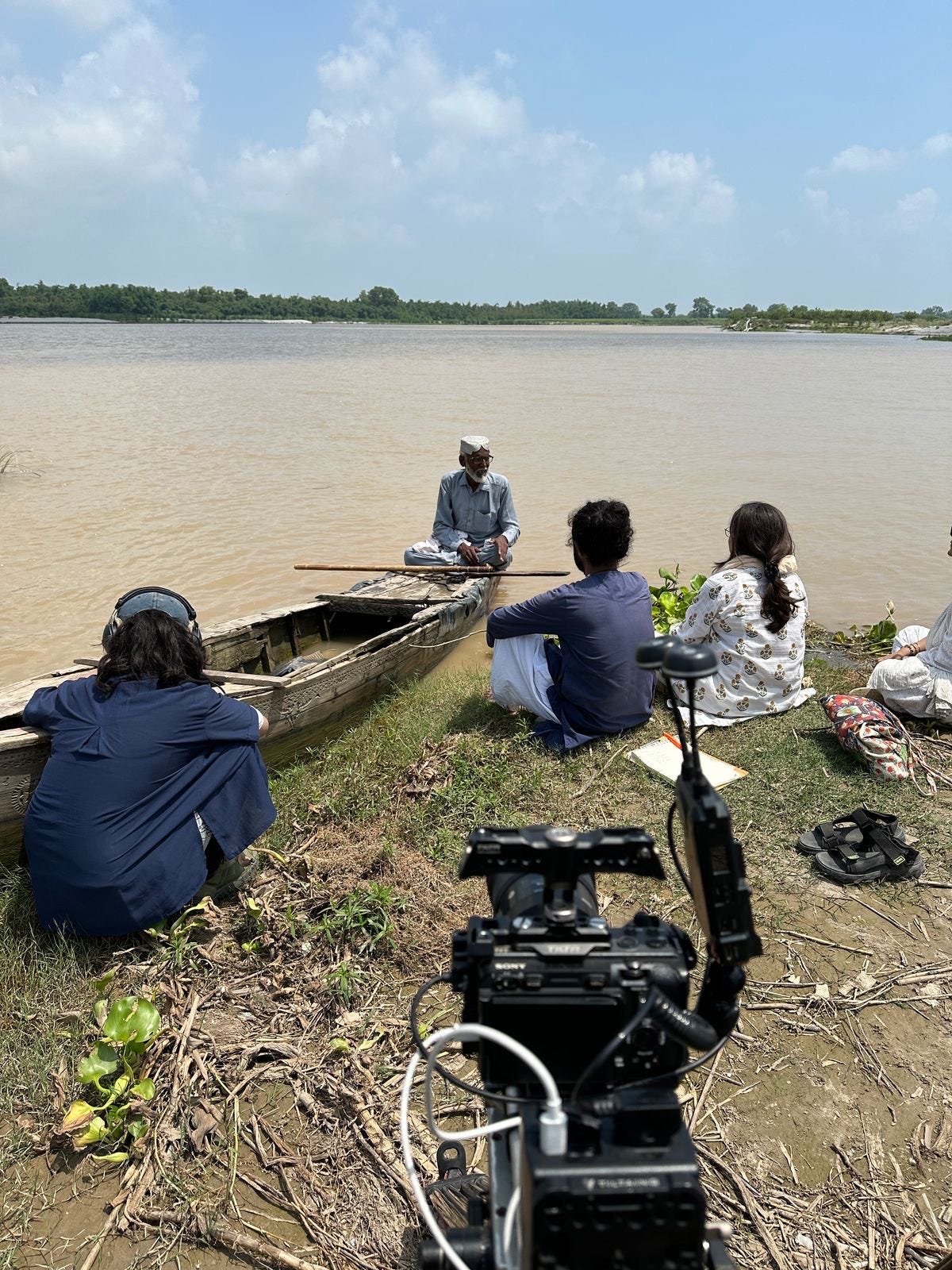
In the backdrop of our interviews with Khairrudun, his children and grandchildren oddly jump in the water as they please. Khairuddin is a natural so retakes are never needed. At one point, he narrates a story in the camera and immediately as he closes, he draws two circles in the air, his eyes revealing a secret while he smiles “We are being watched from all sides right now,” he claims before humming a melody. We look around, behind our shoulders, across the river. He points to two tall towers one on each side of the river. “The OP guards of both Pakistan and India are watching us closely.” He says this with a firm belief that we struggle to believe in.
The veritable proximity to India becomes obvious as we search for our phones to catch up on the time and prioritize remaining shots that still had to be done. My phone tells a different time than everybody else’s, having caught the Indian phone signals. The incongruity of being literally on the same spot but our phones placing us in different time-zones reminds us of the absurdity of the 1947 Partition of the Punjab. It is difficult to comprehend now; it would have been impossible to make sense of it then.
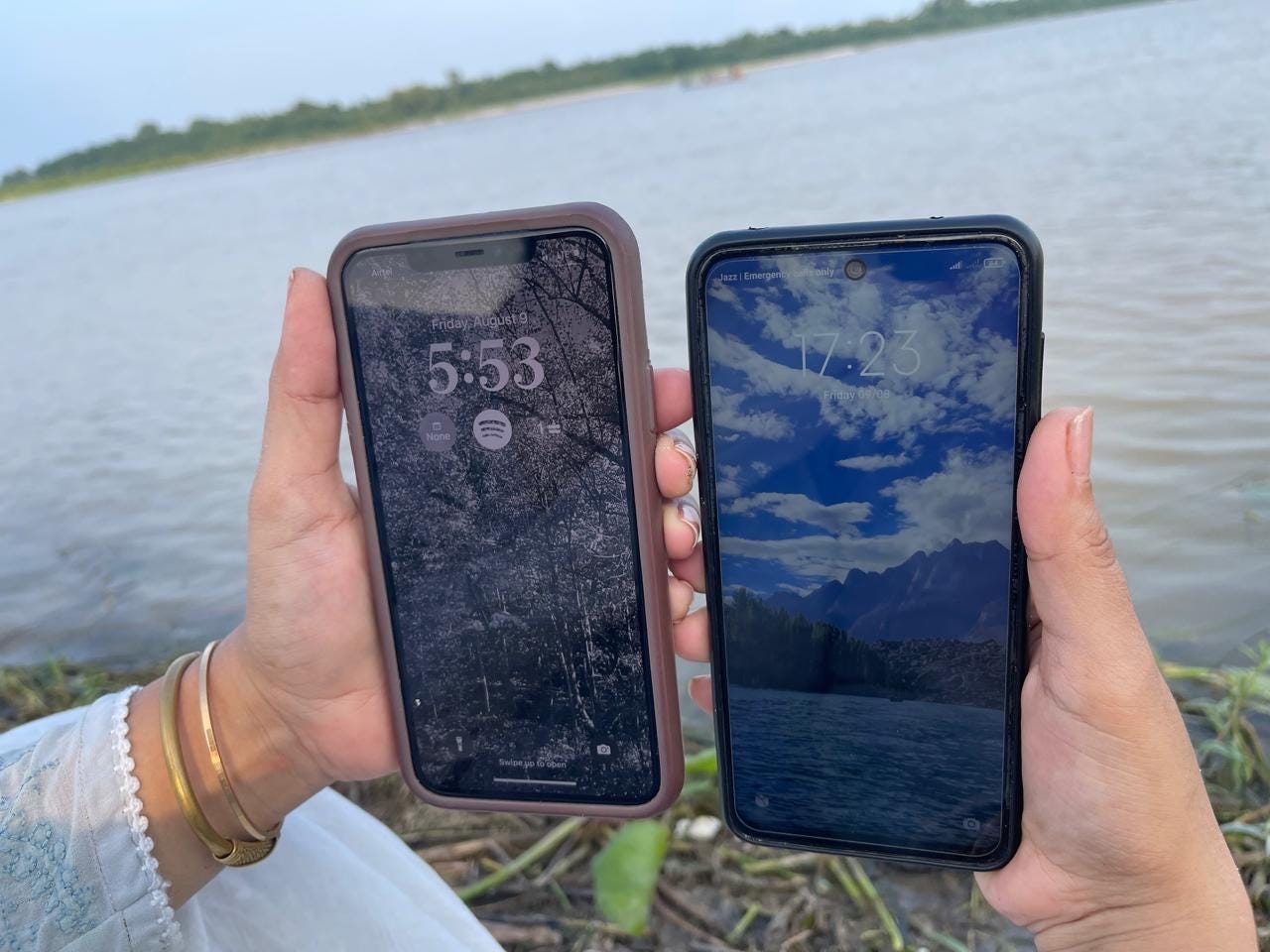
As the sun begins to set, we are treated to a breathtaking sight. The sky is painted with hues of pink and orange, and the river takes on a serene quality. It is a moment of peace, a reminder that even in the most troubled of regions, there is always beauty to be found. But the tranquility is short-lived. The colors of the sunset in the river become blotchy. A bright white light interrupts the river from being engulfed in the deep darkness of the night. The Radcliffe line, which marks the border between India and Pakistan, is illuminated, a stark reminder of the divisions that exist.
We begin to wrap up without saying many words. Borders are a sobering experience. A member of the crew attempts to dissolve the heaviness. He asks whether India and Pakistan fight over the electricity bill. Another one laughs as darkness falls on the villages, inside homes and outside yet the border is eye-sparingly lit. We exchange looks of disbelief followed by the longing of a place, of land and waters, maybe a home, across the blatantly militarized line.
About the Author:
Natasha has been working on issues related to ending violence against women and children for over a decade. She is a writer, filmmaker and activist who is passionate about telling stories that highlight the human impact of social and political issues. Her documentary ‘The Mother, The Sons and the Holy River’ explores the story of Sutlej river and its people. She is the founder of Lok Katha, a South Asian feminist space for women to come together to create films, art and magic.
The documentary film mentioned in the essay, ‘The Mother, The Sons and the Holy River’ is co-directed by Natasha Javed and Nirmal Bano, produced by Abuzar Madhu and supported by Patakha Pictures.


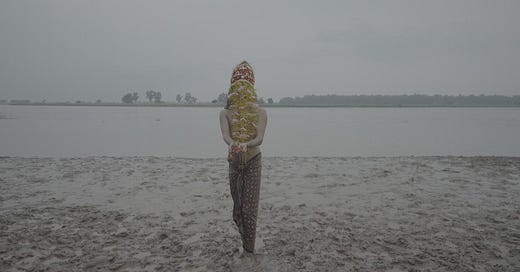





Read this as the first piece in the early morning. Nice to read. Will watch documentary. Rivers are legends and their depth hide untold mysteries.
Favorite line from the write up: "The incongruity of being literally on the same spot but our phones placing us in different time-zones reminds us of the absurdity of the 1947 Partition of the Punjab."
Great to read; would love to see your film!